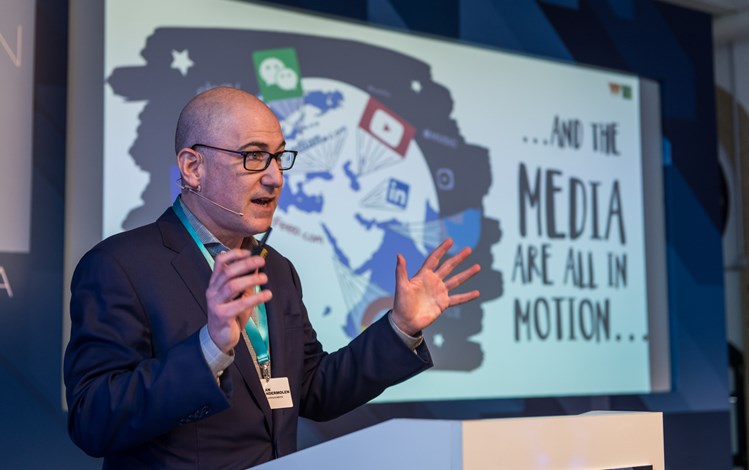WE Communications 08 Jun 2016 // 4:09PM GMT

Last week I had the pleasure of presenting at the Holmes Report In2 Summit in Berlin. This blog post is taken from my talk. I hope you enjoy it.
The U.K. is leading a celebration of the 400th anniversary of the death of Shakespeare. I find this strange as most countries celebrate the anniversaries of the births of their most celebrated daughters and sons, not their deaths. I suspect, however, that there is a quality insight about the British somewhere in this celebration of Shakespeare’s death. And, with the proper context, it could provide fodder for very rich, national storytelling.
That said, the Shakespeare “celebration” and the Holmes Report Innovation Summit in Berlin gave me an opportunity to ponder how The Bard would occur as a modern-day marketing communicator. Or, perhaps more accurately, as a branded content story-maker.
I think Shakespeare would start his dive into our world of disruptive and disintermediating technologies with a sense of freedom from the boundary of the page and the safety of the stage. He would also have a sense of anxiety about the loss of control of the script. I believe he would find inspiration in the notion of technology-enabled motion and what that means for brands and the stakeholders critical to their success.
Let’s take a look at what Shakespeare would see in brands.
He would find brands and their key stakeholders — consumers/customers, partners, employees, investors, competitors — appearing as principal actors in market-based motion relative to one and another. He would see how disruptive technologies have enabled brands to transform entire industries by eliminating anything between the customer and the product or service that does not deliver value. He would see Uber, Airbnb and eBay as proof of this concept. He would witness how technology has enabled subscription-based entertainment services such as Apple Music and Netflix to deliver uninterrupted, anytime and anyplace film, television and music.
He would see how this newly-found brand and consumer freedom has impacted selling and buying behaviors across countless other categories. MetLife is transitioning its traditional sales model in the United States. Tesla has turned the buying model for automobiles on its head by eliminating the dealership.
Shakespeare would see his brand actors enjoying lower costs of sales and much closer and measurable, albeit transactional, relationships with consumers. He would see consumers largely able to build relationships with brands based upon acquiring products or services.
On his media stage, The Bard would find the mobile web shaping a new world of branded news and information. A world where consumers have the power to disintermediate brands that do not provide news, information, entertainment or social value in their stories.
He would find the collision of Google, smartphones, Facebook, Twitter, YouTube, Instagram, mainstreammedia.com, yourbrand.com, paid, earned, shared, and experiential a rich tapestry upon which to practice his craft. However, he would see this media ecosystem as one where science in the form of analytics and insights identification collides with the art of creative in a struggle for the right balance.
He would find a world where brand-owned media, traditional media, social media, digital native media and buying platforms bleed into each other’s spaces. He would experience a media environment where editorial, paid and self-published/self-promoted content blurs the lines of branded-content ownership between the CIO, the CMO and the CCO.
With all of this motion in the Bard’s new world as modern-day marketing communicator, how would he attack his opportunity?
He would embrace technology-enabled transformation in business models, media models and communications models. In fact, I think he would harness that power by shifting from traditional storytelling to transformational, real-time, multiactor story-making. He would enable the multiactor, multiplatform motion to propel brands and their stakeholders to live out ongoing, transformational stories in a nonlinear and intersecting fashion.
He would provide context for the actors — brands, consumers, employees, competitors — to move deliberately and organically forward, making the jump from platform-specific brand episodes to platform-agnostic brand epics. He would embrace the power of a technology-enabled media ecosystem to produce and co-produce consumer-relevant, hyperpersonal and hyperlocal transformational stories with the opportunity to link those to buying platforms.
Before we give up on The Bard’s vision for real-time, transformational story-making, let’s take a quick look at two brands that are already delivering on parts of this promise — one which has been for quite a while.
Launched all the way back in 2006, Nike+ was created as a device to run on Apple’s iPod. The device initially tracked distance and pace of a walk or a run. It had a small transmitter in the shoe that sent a signal to a Nike+ SportBand or an iPod. The SportBand or the iPod then connected through a PC to upload exercise data onto the Nike+ platform on Nike.com. Progress could also be tracked via iTunes. As you would imagine, the technology has evolved now with GPS and the mobile web. The beauty, however, is that Nike created a Nike+ community and put the power of the content in the hands of the community. Members of the community track their progress versus others, and can share local running routes or routes away from home. Also, through the Nike.com platform, members of the Nike+ community can access the latest science and technology of running and running products. So, this is a transformational epic that started in 2006 and continues to move with its actors in a nonlinear and real-time fashion.
Launched on Facebook in 2011, AXA People Protectors is a community focused on highlighting and enabling people in local communities to attack global problems like childhood obesity and access to clean water. AXA complements this with an owned property called borntoprotect.com, which features episodes produced across my health, my family and home, my business, my trips and travel, and my planet. With these social and owned media properties, it also feeds earned media efforts, all combining into an ongoing brand epic about its core proposition: protection.
As we look at our present and what The Bard would consider in taking on his new role, we must remember what he once wrote: What’s past is prologue. In other words, as lines blur between marketing communications disciplines and as technologists, creatives, marketers and communicators blend into a new superspecies, we must remember our PR roots. The success of all this is predicated on being true to earned media editorial principles and maintaining third-party credibility in transformational story-making across a rich and moving media ecosystem.
It is difficult to project if this will be tragedy or comedy; however, it is certain that today’s communicators are writing the script as we live it.
By Alan VanderMolen. President, International and WE+


































.jpg)















